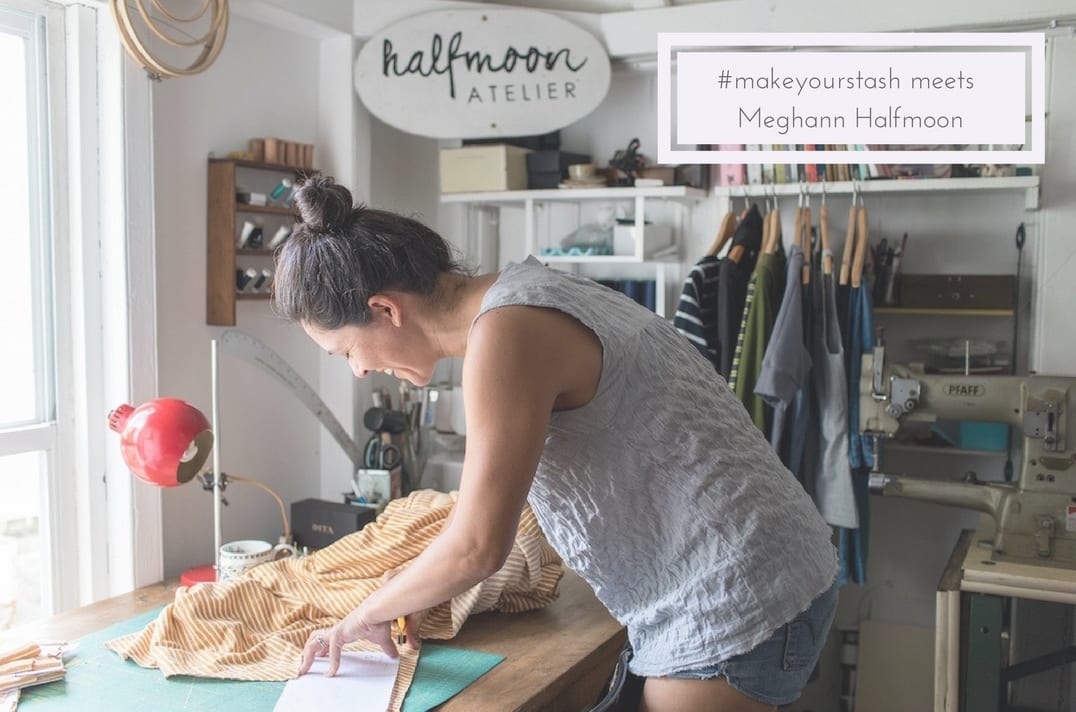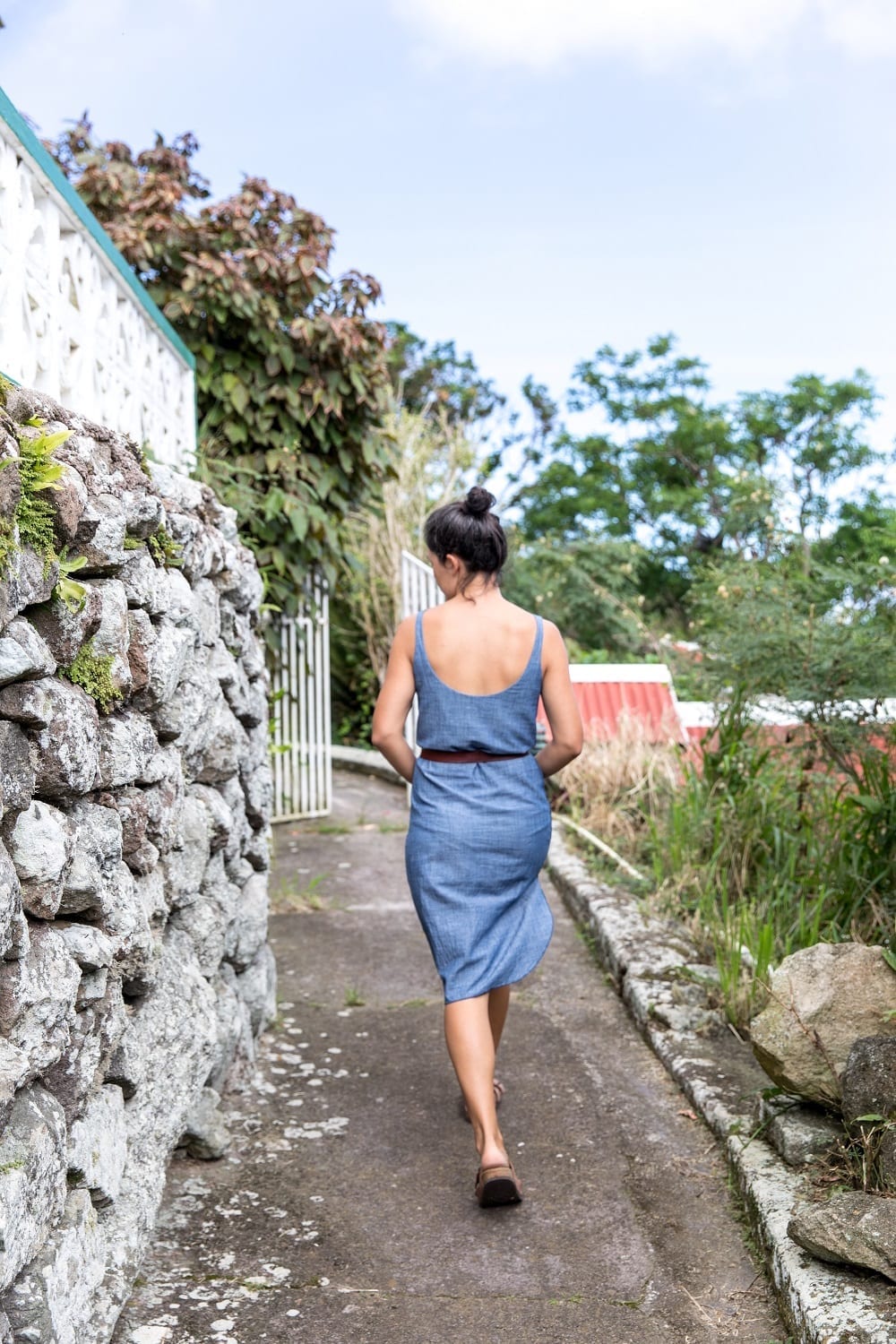
Meghann from Halfmoon Atelier is the only pattern designer I know that has ethical fabric and sustainable sewing as her top priorities. I fell in love with her ethos and aesthetic the first time I saw her website. Her pictures have such cool vibes and still have such a sense of normality! I am so grateful to Pilar for introducing her to me and that Meghann is sponsoring #makeyourstash this month. Here’s what Meghann had to share with us – read on for some inspiration (and potentially a strong desire to also move to the Caribbean).
—
What’s your name and where do live?
My name is Meghann Halfmoon. I live on the small Caribbean island of Saba. Saba is only 13km2 (5 miles2), so it doesn’t make it on to most maps.
What’s on your sewing table right now?
I am currently on holiday…so there’s actually nothing on my sewing table! I just finished my first pair of Ginger Jeans, which felt like a HUGE undertaking. While they didn’t turn out exactly how I’d like them too, I still find it so incredibly satisfying to know that I can make my own jeans!! And, that I’d used old jeans to make new jeans. For April, I am unpicking a vintage skirt that will become another skirt later on in the month. I’ve not completely finalized the design of the skirt – I’m going back and forth between two ideas – but I’m excited to see how it turns out!
What did you do before you became a pattern designer?
I used to work as a grant writer for Plan Nederland, an international development NGO. There were a lot of wonderful things about that career. I loved working to help improve the lives of other people, and of course the travel. I got to visit with people some very remote areas of countries like Mozambique and Guatemala, which always felt very special.
What triggered your interest in sustainable sewing?
I can’t pinpoint one thing. My former career likely has a lot to do with it. Although I’d definitely not call myself an expert, my former career gave me a more direct understanding than most people may have of how connected we all are in the world, whether that is at the moment of purchasing or throwing away.
But my budget also had a lot to do with sustainable sewing. I was upcycling clothing even before I really got into sewing all my clothes. After I had my kids and was in search of myself in my new identity as a mom, I wanted new clothes but either couldn’t afford them or had to settle with “good enough”. So I started making again using my own old clothing or my husband’s clothes that were old, or perhaps had a hole somewhere.
What’s your favourite thing about it?
So many things! It quenches my thirst for making. I get to have clothes that are simple, yet unique (and, oddly, difficult to find in stores). I get to design my own fashion and don’t have to get frustrated spending hours shopping and not finding the right thing. I can just make it! I get to know my body in a more intimate way. And, the most amazing thing: I get to see my designs on other people around the world, which is gold!
What’s the biggest challenge you face when trying to keep your sewing sustainable?
Mistakes and projects that don’t end well. I find that I’ve become quite a perfectionist about sewing because I have stopped purchasing most clothes, so the clothing I make has to really work for my wardrobe!
Being a designer, I sometimes end up with more of one type of garment than I’d generally prefer. And, living on such a tiny island, we don’t have textile recycling here. Luckily, I don’t actually produce much waste in my sewing practice, but I have only recently begun gather my scraps and I plan on using those more in my sewing as well (I’ve almost got enough tiny clippings to make a pillow insert!).
Do you have any tips to keep your sewing mindful and relevant?
Take the time to carefully sew the little details, like understitching, any hand-sewing and careful pressing, etc. These can seem tedious, indeed I used to skip all of these! But the details are what give the crisp, professional finish to your garments and enhance the quality a great deal. That means you’ll love them more, and they’ll keep longer.
I also think it’s a good idea to go through your old clothes first, and your stash second, to see if you can use anything there before purchasing new yardage. Then, if you do need yardage, really think about it and consider how it will go with other things in your wardrobe. You can often get swatches before committing. If you can manage it budget-wise, I suggest buying the fabric that you really love. Then, when you go to make your project, follow the tips above:)
Do you usually shop your stash?
Always. Even though I tend to buy more expensive fabrics, I am still very frugal. It sounds dramatic, but I get a bit panicky if I feel like I’m wasting things. So I keep a very small stash of really high quality fabrics.
To be honest, the fact that I don’t have fabric stores near me makes this very easy. I will be adding a bit to my stash over my holiday as I plan to visit a few fabric stores. But that also means I won’t have to pay shipping for fabrics this year if I manage to find what I need.
If you had to recommend a book, it would be…
Do-It-Yourself Clothes by Cal Patch. This is such an amazing intro to creating patterns for your own body. It’s how I got started turning my designs into patterns several years ago. I now use more professional pattern books to guide my design for the PDF sewing patterns that I sell, but Cal’s book is the best place to start!
What are you looking forward to?
My upcoming patterns! I’ve got two clothing patterns, and one bag pattern, that I’d like to release together as a sort of mini-weekend getaway collection for the summer. I may end up releasing them separately, but we’ll see how it goes.
—
Thanks Meg and we also look forward to seeing your new patterns!
PS – if you love the dress below, its the Delpy dress which is available as a pdf on the Halfmoon Atelier website. All photo credits in this post to Erin Little.



1 comment
“I keep a very small stash of really high quality fabrics” – goals!!! Thanks Meghann and thanks Kate for the wonderful interview.